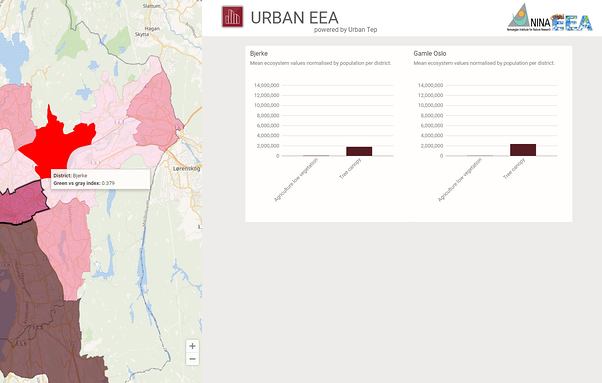The UN System of Environmental Economic Accounting (SEEA) is a framework used to integrate economic and environmental information in order to understand key links between the economy and the environment, based on the idea of “natural/environmental capital” stocks and changes in such stocks, as they contribute to human wellbeing. It is based on internationally agreed standard concepts, definitions, classifications, accounting rules and tables for producing internationally comparable statistics and accounts. The SEEA framework is compatible with the System of National Accounts (SNA) to facilitate the integration of SEEA into official environmental and economic statistics. (https://seea.un.org/content/homepage). Within SEEA, Experimental Ecosystem Accounting (EEA) provides a statistical framework for measuring ecosystem services, tracking changes in ecosystem assets and linking this information to economic and other human activity (UN, 2017). Ecosystem accounts integrate spatial information about change over time in ecosystem extent, condition, physical and monetary supply and use of ecosystem services, and monetary value of ecosystem assets. The aim of ecosystem accounts is to provide an integrating decision-support tool at national level for assessing how policies in aggregate affect the contribution of ecosystems to the economy.
Ecosystem accounting for urban areas is a rapidly developing field within EEA as it is recognised that cities contain the majority of the world’s population, are predicted to grow, and are one of the major causes of ecosystem conversion. Accounting for loss and restoration of urban green spaces and green infrastructure such as street trees within cities is a technical challenge with large potential societal benefits through better municipal planning and policy. Many city governments will not have their own technical resources and data to compile their own ecosystem accounts, revealing a potential for platforms that preprocess geostatistics following UN standards for ecosystem accounting (currently under development). There is a need for pilot testing of different approaches and platforms for urban ecosystem accounting (Wang et al 2019).
Together with a research team from the Norwegian Institute for Nature Research (NINA), the TEP Urban team prepared a demonstrator for interactive analysis of the ecosystem state in the city of Oslo. NINA is researching different ways in which ecosystem accounting data can be recompiled to address different municipal purposes, including (i) awareness raising and policy instrument design. The demonstrator has focused on the purpose of raising awareness of the value of urban green, and especially urban trees, for the public. The initial results of our collaboration are visible at Panther 3
The TEP Urban platform and initial demo applications for urban ecosystem accounting were recently presented at the Urban accounting session of the SEEA EEA annual forum meeting in Glen Cove, New York (25-27 June 2019). Participants commented on the potential in the TEP Urban platform for on the fly tabulation and graphics. Whereas the current demos of TEP Urban focus on urban/settlement footprint at global scale, the main interest of the participants was in using TEP Urban to account for losses and gains in urban green extent and vegetation condition (eg. tree canopy) using high resolution remote sensing data. While sufficient for national and regional aggregate global statistics on urban settlements over longer time periods, participants remarked that for municipal planning purposes the global urban footprint and settlement data computed by TEP Urban was not sufficiently accurate compared to cadastre data used by municipalities. Participants appreciated the potential in the TEP Urban platform for automatically compiling accounting tables and stats graphics on an annual basis, as RS data became available. Participants appreciated the compilation of greenspace data at administrative unit level for its policy relevance, while noting the need to normalise statistics for statistical units of unequal size. Further demonstration was called for.
Vision
The TEP Urban vision for the SEEA purposes is to provide users from the cities around the world with a simple interactive tool for communicating ecosystem accounting data to planners and the public of their city. Such a tool must be able to generate the results for the requested cities on the fly when requested. To decrease the price of the processing the data needs to be cached.
A key task of ecosystem accounting is reporting change in space and time. The Oslo demo presented at the SEEA EEA Forum, showed approaches to aggregating data by administrative unit (city district) as well as zooming in to the street and neighbourhood level where data allow. In addition to the capability to compile and illustrate city specific statistics (e.g. individual tree canopies and their ecosystem services in Oslo), TEP Urban should be able to produce basic ecosystem extent accounts recommended by SEEA EEA. The possibility to generate the results automatically from the Sentinel Earth Observation data would give us the possibility to analyze the changes in long time series.
NINA researchers expressed an interest in continuing to collaborate with TEP Urban in developing new demonstrations of mapping and statistics of direct use to city planners.

